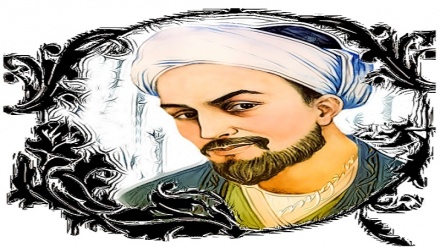Iranian Notables, Sources of Global Honor (86)
In this episode, we speak of the Iranian mystic, Mir Seyed Ali Hamedani, who lived in 8th Century AH.
The acclaimed Iranian mystic of 8th Century AH, Seyed Ali Hamedani, spent a lifetime for promotion of divine religion of Islam, purification of soul, and education of those, who were interested in truth and righteousness, in Kashmir and Tajikistan. He earned the title of Sultan al-Arefin among scientists. His followers referred to him as the King of Hamedan, and he is also popularly known as Hazrat Amir Jaan in Tajikistan.
The Iranian mystic, Mir Seyed Ali Hamedani, is well known in parts of the Indian Subcontinent, including Kashmir, due to his contribution to promotion of the divine religion of Islam. Some researchers believe that his visit to Kashmir in 8th Century AH, in the company of a number of his followers, led to promotion of Shiism in that land. He has also left numerous books in Farsi prose and verse, which have played a crucial role in promotion of Iranian culture and Farsi language in the Indian Subcontinent. He maintains countless followers in Kashmir, and the monastery, which was his place of residence, has turned into a site of pilgrimage. Given that his tomb is located in Tajikistan, he is also well-known over there.
Seyed Ali Hamedani was born in the city of Hamedan in western Iran, on Monday, 12th of Islamic month of Rajab, in 714 AH. His father, Amir Shahab Ed-Din Hassan Ibn Seyed Mohammad Hamedani, was a faithful man, and ruler of Hamedan.
Seyed Ali Hamedani completed his primary studies under his maternal uncle, Seyed Ala Ed-Din. At the age of twelve, Seyed Ali Hamedani continued his studies by attending the classes of Sheikh Abu Al-Barkat Taqi Ed-Din Ali Dousti. Throughout his years of education, he excelled in the science of Hadith, philosophy, and mysticism, and was influenced by his lecturers in domains such as purification of soul, and spiritual elevation.
After attending the classes of prominent lecturers, Seyed Ali Hamedani was missioned by over thirty clerics to promote the sacred religion of Islam, overseas. He endured the hardships of journeys and traveled to different regions of Shaam, Turkistan, Kashmir, and India, while paying pilgrimage to Holy Ka’ba on several occasions. In total, he traveled for twenty-one years and never settled down anywhere. Amid his long journeys, he spiritually benefitted from 1,400 mystics and lecturers. In the year 753 AH, he returned to Hamedan and got married. In the year 773 AH, he once again left his home country and headed overseas.
Seyed Ali Hamedani groomed several students in Iran, Central and South Asia. The best known and most virtuous student of Seyed Ali Hamedani is Nur Ed-Din Jafar Badakhshi, who attended Hamedani’s classes in Central Asia.
Khajeh Ishaaq Khatlani is one of the other students of Seyed Ali Hamedani, who later became the latter’s son in law, and accompanied Hamedani in many of his journeys. Khatlani groomed countless learners of Islamic teachings for half a century.
Mir Seyed Hussein Semnani, who is known for his virtues, was also send by Seyed Ali Hamedani to Kashmir on a number of occasions to promote the divine religion of Islam.
Seyed Ali Hamedani was highly respected in his lifetime. In the majority of cities of Iran, Turkistan, and India; people from all walks of life respected him. In addition to his piety, he attained an elevated status in science, and philosophy, mastering the rational and traditional sciences of his era, and authoring countless books in these domains. His spiritual influence among people led many of his contemporary rulers to respect him; and to implement his advices. The house that Seyed Ali Hamedani had chosen in Kashmir as a base for deliverance of sermons and promotion of Islam was turned into a mosque by locals. As of early 9th Century AH up to now, this building has been one of the most important centers of activities of Muslims in the Indian Subcontinent. A significant number of schools and mosques in Kashmir and Jammu have been named after Seyed Ali Hamedani.
Every year, on 6th of Islamic month of Zil Hajja which marks the anniversary of demise of Seyed Ali Hamedani, a number of memorial services are held in Kashmir and other predominantly Muslim regions of the Indian Subcontinent, throughout which his virtues and teachings are mentioned.
Many historians and researchers have written books in prose and verse, commending Mir Seyed Ali Hamedani, while translating a number of Hamedani’s books into Urdu, Turkish, Pashtun, and French languages. The writings of Seyed Ali Hamedani total more than 110 volumes.
In the year 786 AH, Seyed Ali Hamedani left Kashmir to observe Hajj Pilgrimage. A few days after the start of his journey, the ruler of Pakhli invited him to spend a number of days in his land and to preach its people. He accepted, delivering a number of speeches over there for a period of ten days. In continuation of his journey, he fell ill, passing away on Wednesday, 6th of the Islamic month of Zil Hajja in the year 786 AH. It is said that he passed away in the frontier regions of Iran and Afghanistan.
The tomb of Seyed Ali Hamedani is currently in the Central Asian country of Tajikistan, which includes a large chamber, and nine small stalls. Ten members of his dynasty have been laid to rest in this tomb.
Following the demise of Seyed Ali Hamedani; his son, Seyed Mohammad, succeeded his father and continued his efforts. In the year 800 AH, Seyed Mohammad left India for Mecca and observed the Hajj rituals. He passed away in the year 809 AH, and was laid to rest next to his father.
MR/MG


